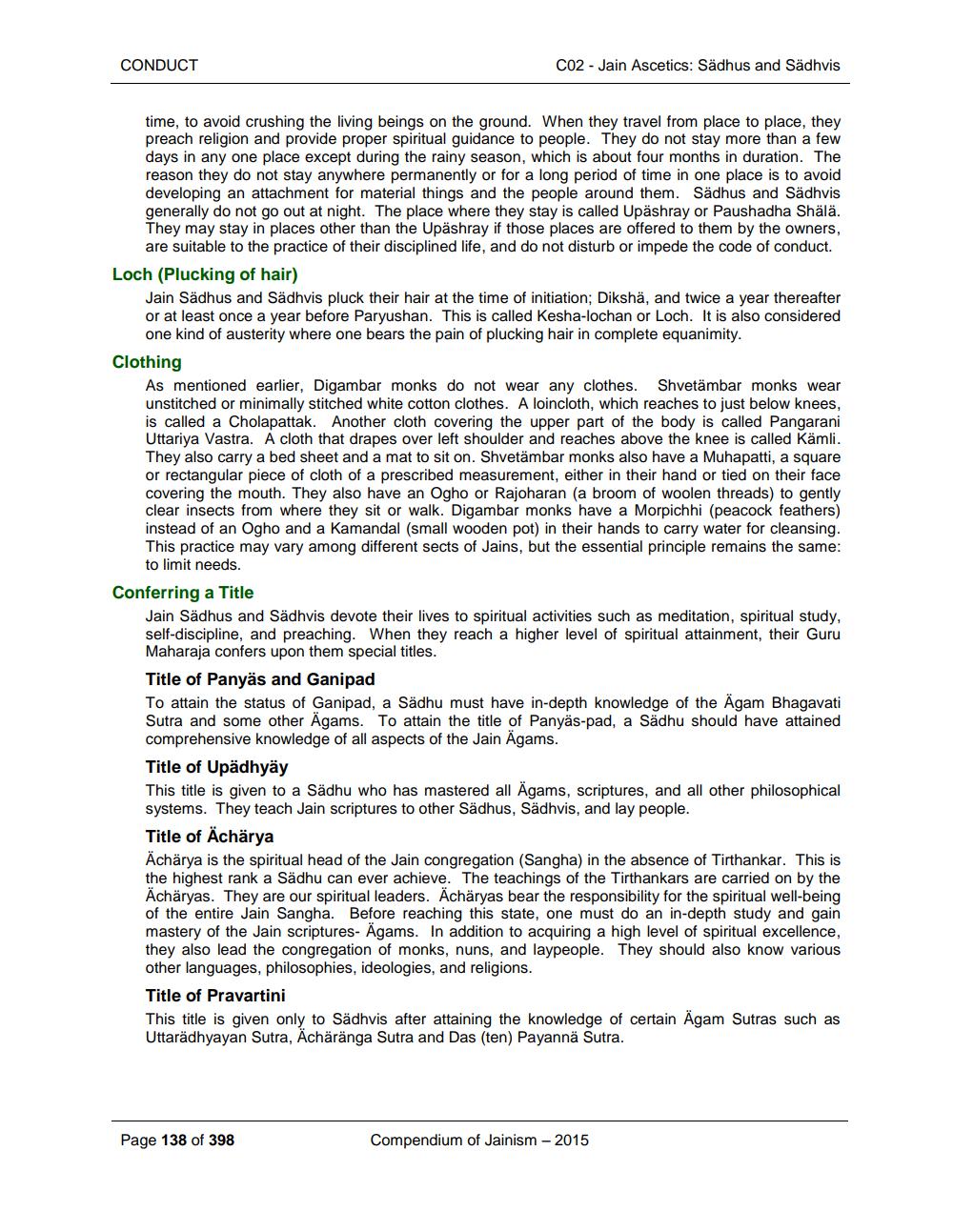________________
CONDUCT
C02 Jain Ascetics: Sädhus and Sädhvis
time, to avoid crushing the living beings on the ground. When they travel from place to place, they preach religion and provide proper spiritual guidance to people. They do not stay more than a few days in any one place except during the rainy season, which is about four months in duration. The reason they do not stay anywhere permanently or for a long period of time in one place is to avoid developing an attachment for material things and the people around them. Sädhus and Sädhvis generally do not go out at night. The place where they stay is called Upäshray or Paushadha Shälä. They may stay in places other than the Upäshray if those places are offered to them by the owners, are suitable to the practice of their disciplined life, and do not disturb or impede the code of conduct.
Loch (Plucking of hair)
Jain Sädhus and Sädhvis pluck their hair at the time of initiation; Dikshä, and twice a year thereafter or at least once a year before Paryushan. This is called Kesha-lochan or Loch. It is also considered one kind of austerity where one bears the pain of plucking hair in complete equanimity.
Clothing
As mentioned earlier, Digambar monks do not wear any clothes. Shvetämbar monks wear unstitched or minimally stitched white cotton clothes. A loincloth, which reaches to just below knees, is called a Cholapattak. Another cloth covering the upper part of the body is called Pangarani Uttariya Vastra. A cloth that drapes over left shoulder and reaches above the knee is called Kämli. They also carry a bed sheet and a mat to sit on. Shvetämbar monks also have a Muhapatti, a square or rectangular piece of cloth of a prescribed measurement, either in their hand or tied on their face covering the mouth. They also have an Ogho or Rajoharan (a broom of woolen threads) to gently clear insects from where they sit or walk. Digambar monks have a Morpichhi (peacock feathers) instead of an Ogho and a Kamandal (small wooden pot) in their hands to carry water for cleansing. This practice may vary among different sects of Jains, but the essential principle remains the same: to limit needs.
Conferring a Title
Jain Sädhus and Sädhvis devote their lives to spiritual activities such as meditation, spiritual study, self-discipline, and preaching. When they reach a higher level of spiritual attainment, their Guru Maharaja confers upon them special titles.
Title of Panyäs and Ganipad
To attain the status of Ganipad, a Sädhu must have in-depth knowledge of the Ägam Bhagavati Sutra and some other Ägams. To attain the title of Panyäs-pad, a Sädhu should have attained comprehensive knowledge of all aspects of the Jain Ägams.
Title of Upadhyay
This title is given to a Sädhu who has mastered all Ägams, scriptures, and all other philosophical systems. They teach Jain scriptures to other Sädhus, Sädhvis, and lay people.
Title of Ächärya
Ächärya is the spiritual head of the Jain congregation (Sangha) in the absence of Tirthankar. This is the highest rank a Sädhu can ever achieve. The teachings of the Tirthankars are carried on by the Ächäryas. They are our spiritual leaders. Ächäryas bear the responsibility for the spiritual well-being of the entire Jain Sangha. Before reaching this state, one must do an in-depth study and gain mastery of the Jain scriptures- Ägams. In addition to acquiring a high level of spiritual excellence, they also lead the congregation of monks, nuns, and laypeople. They should also know various other languages, philosophies, ideologies, and religions.
Title of Pravartini
This title is given only to Sädhvis after attaining the knowledge of certain Ägam Sutras such as Uttarädhyayan Sutra, Ächäränga Sutra and Das (ten) Payannä Sutra.
Page 138 of 398
Compendium of Jainism - 2015




